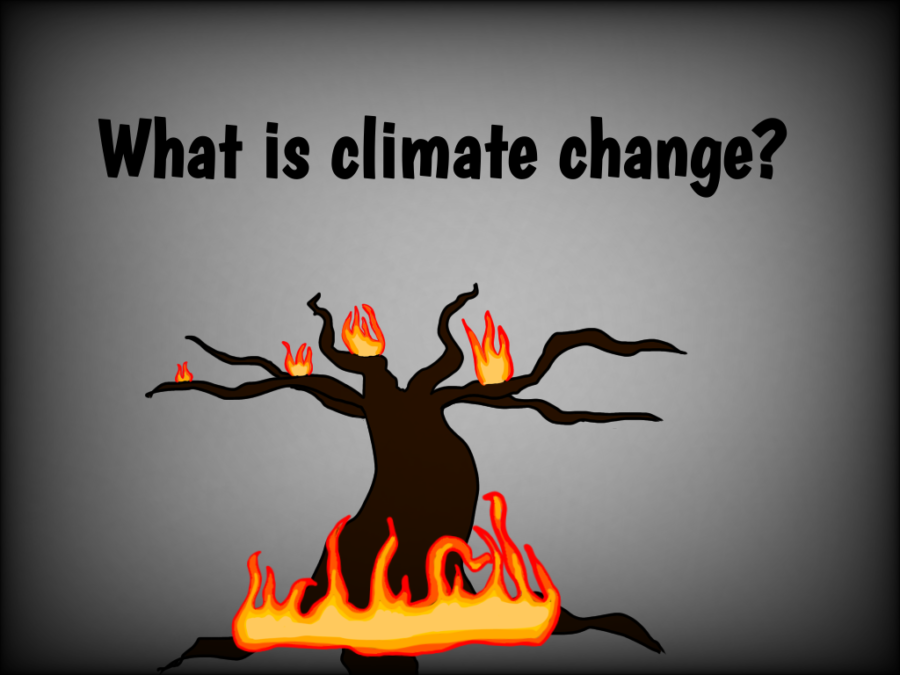What is Climate Change anyway?
August 27, 2020
According to Dr. Suprenand, Climate Change is “a way that you can describe long-term, in this case rapid changes [in climate] that are out of the ordinary from anything that has been recorded in the last couple hundred if not over a million years.” Further, the definition includes not only temperature, but also weather. Think hurricanes, flooding, and general extreme weather. The weather won’t necessarily get worse, just less predictable.
For example, look at the polar vortex that traveled over the Midwest this past January. Currents of polar air that originated in the Arctic blasted into the American Midwest, and believe it or not, they were actually caused by warming temperatures. The polar jet stream is made by currents of air that run along the poles. In the Arctic, a hotter climate is weakening this current. This debilitated jet stream allows polar air to seep out, and come to America.
Skeptics argue that this onslaught of colder winters refutes the possibility of global warming, as things are actually getting colder. But according to sources, there two key points that discredit this viewpoint:
- While yes, it is true that winters are getting colder, this is actually just a repercussion of temperatures rising. Especially in the Arctic, where things are heating up at an accelerated pace, alterations to climate lead to polar air escaping and cooling down the rest of the world, along with the colder temperatures associated with glaciers melting.
- There’s a reason that scientists prefer the term “climate change” to the less accurate “global warming.” Climate change is a broad term. It can mean rising temperatures, but it can also mean falling ones and excess variation in weather patterns. Conversely, global warming is simply the rise of temperature. While most of the effects of climate change can be attributed to global warming, it is more accurate to refer to the climate crisis as being ushered in by climate change, since it encompasses all aspects of this epidemic as well as leaving less room for confusion. So when events such as the polar vortex happen, are they caused by rising temperatures and therefore global warming? Yes. But technically speaking, using a term like Climate Change is the better way to go.
In Florida, while there aren’t any polar vortexes, one tangible effect of climate change is rising temperatures. Florida is statistically the state most at risk to rising heat and humidity. These two factors, when coupled together, are what determine the heat index, or how hot it actually feels.
Take Miami. The number of danger days (days with a heat index over 105 ̊F) that The Magic City will face over the coming years is drastically increasing. In 2000, the number was just 24 per year. In 2030, that number is expected to increase by nearly six times, coming in at 126 danger days per year. In 2050, it will be 151 danger days, That’s over forty percent of a whole year.
The National Weather Service lists heat as the most common weather-related death in America. Danger days can lead to a whole host of health problems, such as dehydration, kidney failure, heart failure, and heatstroke. Couple that with Florida’s high concentration of the elderly, who are more susceptible to heat-related illnesses and deaths, and one can see how incredibly detrimental rising temperatures will be for the Sunshine State.
So what is it, exactly, that’s causing this climate crisis? It must have been some crazy anomaly, right? Well, the answer is not as shocking as one might expect.
It’s actually a naturally occurring process called the greenhouse effect. Gases in the atmosphere trap heat in the form of solar energy and send it back towards earth. Without human interference, the greenhouse effect acts naturally to keep earth warm enough to sustain life.
But starting around the Industrial Revolution, Suprenand explains, “we’ve seen rapid changes in the global mean temperature as well as carbon dioxide concentrations … meaning there are a lot of ways in which things like cars and gasoline, and all the other refined products that started to basically explode in production at the same rate as the human population are affecting Earth.”
Gases such as carbon dioxide, methane, and nitrous oxide have been produced in excess, and they end up in the atmosphere, trapping more heat than necessary and sending it back to earth. These gases all contribute heavily to the greenhouse effect.
To see a more in-depth analysis of what these gases do and why there is too much of them in the atmosphere, check out this page from NASA’s website.
According to Suprenand, Climate Change is an anthropogenic, or human-caused issue that will require a human-driven solution. In other words, this whole Climate Change thing isn’t going to just work itself out.
